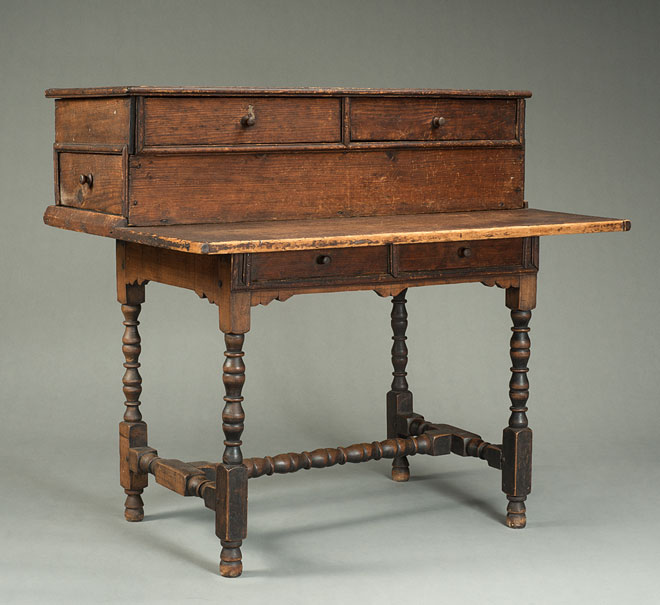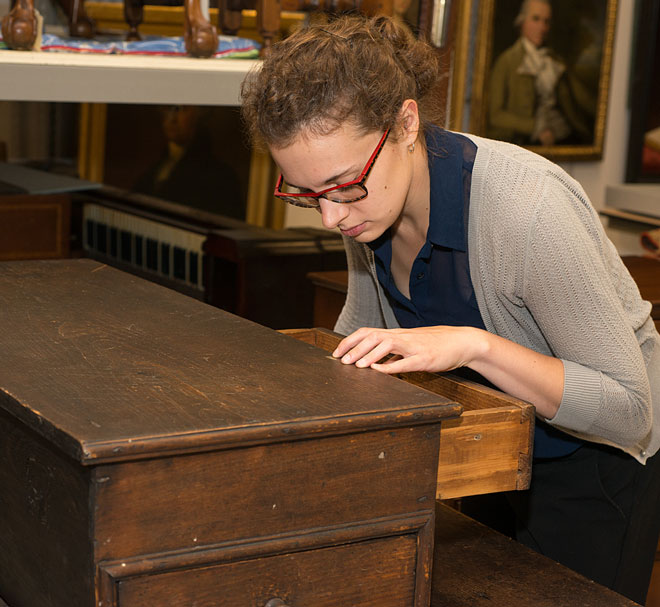To someone laying eyes on Historic Deerfield’s newly acquired table-desk for the first time, this artifact appears nothing special. It’s just over three feet tall and runs three and a half feet in length. Its boards are plain, though the table apron’s detailed edge suggests that its unknown maker took some care in its construction. The writing surface is well-worn, bearing the marks of centuries of use. When placed next to some of Historic Deerfield’s more ornate case pieces, the table-desk is an ugly duckling to say the least. Despite its ungainly appearance, however, I’ve developed a soft spot for this desk in the time I’ve spent as an intern in Historic Deerfield’s curatorial department. On my first day, I was entrusted with the task of tracing the table-desk through three centuries, filling the gaps in its history. The table-desk’s first known owner was Puritan Minister Nehemiah Bull (1701-1740) of Westfield, Massachusetts, but it’s very first owner and subsequent holders after Bull were a mystery. My search through thousands of probate inventory1 pages and additional secondary sources has been a saga of patience and stubborn determination, punctuated by the occasional heartbreak and exhilarating moments of success.

Probably Springfield, Massachusetts
ca. 1690, hard maple, white pine, yellow pine, iron
Museum Purchase with partial funds given in memory of Lawrence K. Wagenseil
The upper portion of this piece was made with writing in mind. By designing the middle drawers to open sideways, the unknown craftsman made sure that anyone writing at the table-desk would not have to move his or her papers in order to access the drawers. Similarly, the upper drawers are high enough above the writing surface to prevent paper-shuffling. Additionally, the two long, side drawers span the width of the table-desk, offering ample room for storing books and materials.
Although I am still searching for definitive information concerning the table-desk’s commission and early years, its construction holds several clues. The style of its turned legs, for example, is highly suggestive. These ball-and-ring turnings stylistically resemble others from the William and Mary period built between 1680 and 1700, narrowing the initial search window. Additionally, the upper right drawer bears the handwritten inscription “Nehemiah Bull,” which provides a helpful starting point. Nehemiah Bull was born in 1701 and graduated from Yale College in 1723. He was ordained in Westfield in 1726 to assist the then-ailing Reverend Edward Taylor with his ministerial duties. Taylor died in 1729, and Bull succeeded him as full-time minister. When Bull subsequently died in 1740, his probate inventory indicates that he owned a “scrutoire,” or writing desk, worth five pounds.
These few facts raise a number of critical questions. Since Bull was born in 1701 and the table-desk was likely made around the turn of the eighteenth century, it follows that he was not the first owner. Who, then, commissioned and first owned the table-desk? Furthermore, who inherited it after Bull’s death?

It is entirely possible that Bull inherited the table-desk from his mentor, Edward Taylor. Originally from England, Taylor arrived in Boston in July of 1668, graduating from Harvard three years later in 1671. In November of the same year, he accepted a ministry position in Westfield, Massachusetts. Though he dutifully served as a minister during his adult life, Taylor is better remembered for his posthumously-published poetry. As a poet, it is logical for Taylor to have owned a writing desk to facilitate his craft and hold his numerous papers and books. Furthermore, Taylor’s probate inventory indicates that he owned a “Study Table” valued at ten shillings at the time of his death. Though the significant price discrepancy raises some doubt, it is possible that this furniture piece could be the table-desk.
After Bull’s death, the table-desk would most likely have gone to one of his four sons: William, John, Justin, or Nehemiah Jr. Almost exactly one month after I began research, I located a reference to “1 writing table with draw[er]s” worth four pounds in Nehemiah Bull Jr.’s probate inventory. Nehemiah Jr. died in 1814, and his 1816 probate inventory locates the desk in his home in Lanesborough, Massachusetts. Needless to say, I danced around the office. The dance continued when I located Nehemiah Jr.’s will, in which he leaves “[his] parents [sic] estate [his] wearing apparel [his] books and all [his] household furniture” to his nephew, William Bull, who apprenticed as a physician near his uncle in Lanesborough. Though I am still locating William’s will and probate inventory, I am hopeful that these documents will yield more clues about the table-desk’s history and its descent in the Bull family.
Ultimately, this humble piece of furniture demonstrates the power of material culture. Using this artifact, Historic Deerfield’s curators can educate visitors about early eighteenth-century furniture craftsmanship and tell visitors the story of the Bull family as well. Visitors can imagine Bull sitting down at the table-desk, organizing his books and papers in the drawers, drafting his sermons, and balancing his account book. The table-desk offers a specific window into the past, and working to clear the fog from this window has been one of the most rewarding parts of my internship.
[1] In early America, when a household head died, a court-appointed appraiser made a complete list of all the dead individual’s property, from his or her wearing apparel, to furniture, to tools, to the last thimble. The resulting document is called a probate inventory.